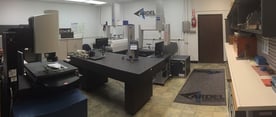Before there was geometric dimensioning and tolerancing (or GD&T for short), manufacturers relied almost entirely upon linear dimensioning to achieve standardization of parts.
 Linear dimensioning is simply the practice of measuring a given distance to the most exact possible degree of accuracy. It was during the Second World War that GD&T was first discovered and applied. A British inspector of submarine torpedo parts, a man named Stanley Parker, discovered that certain components which wouldn’t normally seem qualified for military specifications were actually fit to be used in torpedoes. Instead of throwing the parts away as would normally be done, Parker realized that if the components were mated together with other parts to a reasonable degree of tolerance, then they still met the requirements of military specifications, and were good to go. Naturally, this saved Parker time and effort in the fast-paced business of providing for the British Royal Navy.
Linear dimensioning is simply the practice of measuring a given distance to the most exact possible degree of accuracy. It was during the Second World War that GD&T was first discovered and applied. A British inspector of submarine torpedo parts, a man named Stanley Parker, discovered that certain components which wouldn’t normally seem qualified for military specifications were actually fit to be used in torpedoes. Instead of throwing the parts away as would normally be done, Parker realized that if the components were mated together with other parts to a reasonable degree of tolerance, then they still met the requirements of military specifications, and were good to go. Naturally, this saved Parker time and effort in the fast-paced business of providing for the British Royal Navy.
Today, GD&T is used for any number of commercial applications. Since design work on components is usually helped along – nowadays – by using CAD computer design programs, GD&T has become more essential than ever. With a CAD program, one can design a “perfect” base template for a component. With the knowledge of the GD&T process, one can predicate the range of tolerance that any given component can “fall” under. With production schedules more cramped than ever before, and the demand for failure-proof components higher than ever, GD&T – when used correctly – strikes a healthy balance between “perfect” and “serviceable.”
Of course, many companies in North America (and throughout the world) don’t really have a full command of the GD&T process. Fortunately, that isn’t the case here at Ardel Engineering. With our team of GD&T-trained machinists and quality inspectors, we make sure that production runs go smoothly and accurately – with little or no rejection rate. Please send us your latest design for us to give you a competitive quote on.

